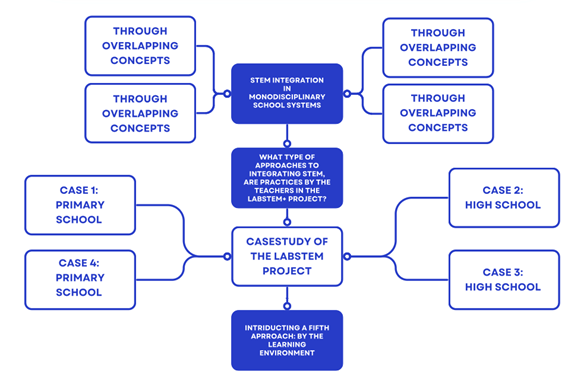Expanding the STEM integration model introducing the learning environment
DOI:
https://doi.org/10.31129/LUMAT.12.4.2379Keywords:
STEM education, integration model, learning environmentAbstract
The increasing demand for a future-ready workforce, driven by rapid technological advancements, has positioned STEM (Science, Technology, Engineering, and Mathematics) education as a global priority. Despite its recognized importance, integrating STEM within traditionally monodisciplinary educational systems poses significant challenges. These include rigid curricula, subject compartmentalization, and institutional constraints that hinder interdisciplinary collaboration. This study aims to address these challenges by proposing an expansion of the existing STEM integration model developed by Seidelin and Larsen in 2021, which originally includes four approaches: content integration, overlapping methods integration, overlapping concepts integration, and context integration. The proposed expansion introduces a fifth element focused on the learning environment, recognizing the critical role that physical spaces, local contexts, and materials play in shaping integrated STEM education. The study draws on insights from the Danish LabSTEM+ project, where educators utilized what the project calls a laboratory model to explore the impact of the learning environment on STEM teaching. Methods included field observations, interviews, and the analysis of four case studies involving diverse educational contexts. The results demonstrate that the learning environment serves as a new way of integrating STEM. This addition of a fifth element to the integration model by Seidelin and Larsen offers a more comprehensive framework for STEM integration. The study concludes that the learning environment can be seen as a core component of developing integrated STEM teaching.
References
Artigue, M. & Blomhøj, M. (2013). Conceptualizing inquiry-based education in mathematics. ZDM, 45(6), 797–810. DOI: https://doi.org/10.1007/s11858-013-0506-6
Bertel, L. B., Møller Jeppesen, M., & Lisborg, S. (2023). Problembaseret læring på tværs af uddannelseskæden: Hvordan kan vi styrke overgange i STEM gennem arbejdet med autentiske problemer? EMU Danmark Læringsportal. https://www.emu.dk/htx/teknikfag/overgange/problembaseret-laering-paa-tvaers-af-uddannelseskaeden?b=t432-t481
Brown, A.L. (1992). Design experiments: Theoretical and methodological challenges in creating complex interventions in classroom settings. Journal of the Learning Sciences, 2, 141–178. DOI: https://doi.org/10.1207/s15327809jls0202_2
Bybee, R.W. (2018). STEM Education Now More Than Ever. NSTA Press.
Carr, W. & Kemmis, S. (2005). Staying Critical. Educational Action Research, 13(3), 347–358. DOI: https://doi.org/10.1080/09650790500200296
Doğan, M. F., Gürbüz, R., Erdem, Z. Ç., & Şahin, S. (2019). Using Mathematical Modeling for İntegrating STEM Disciplines: A Theoretical Framework. Türk Bilgisayar ve Matematik Eğitimi Dergisi, 10(3), 628–653. DOI: https://doi.org/10.16949/turkbilmat.502007
Gardner, M., & Tillotson, J. W. (2019). Interpreting integrated STEM: Sustaining pedagogical innovation within a public middle school context. International Journal of Science and Mathematics Education, 17(7), 1283–1300. DOI: https://doi.org/10.1007/s10763-018-9927-6
Guzey, S. S., Moore, T. J., & Harwell, M. (2016). Building up STEM: An analysis of teacher-developed engineering design-based STEM integration curricular materials. Journal of Pre-College Engineering Education Research (J-PEER), 6(1), 2 DOI: https://doi.org/10.7771/2157-9288.1129
Keiding, T. B. (2010). Rummet som didaktisk kategori. Uddannelsesnyt, 21(3), 4–9
Klausen, S.H. (2011). På tværs af fag: Fagligt samspil i undervisning, forskning og teamarbejde. Akademisk Forlag.
Larsen, H.H. & Svabo, C. (2002). Fra kursus til kompetenceudvikling på jobbet. Jurist- og Økonomforbundets Forlag.
Larsen, D. M., Kristensen, M. A., & Svabo, C. (2024). Expanding the horizons of mathematics in STEM: Diverse mathematical roles in STEM activities. In Anderson, J., Makar, K. (eds) The Contribution of Mathematics to School STEM Education: Current Understandings (pp. 85–102). Singapore: Springer Nature Singapore. https://doi.org/10.1007/978-981-97-2728-5_5 DOI: https://doi.org/10.1007/978-981-97-2728-5_5
Larsen, D. M., Lindhardt, B. K., & Misfeldt, M. (2022). Undersøgende matematik. I S. Skov Fougt, J. Bundsgaard, T. Hanghøj, & M. Misfeldt (red.), Håndbog i Scenariedidaktik (s. 203–216). Aarhus Universitetsforlag DOI: https://doi.org/10.2307/j.ctv33jb48k.17
Nadelson, L. S., & Seifert, A. L. (2017). Integrated STEM defined: Contexts, challenges, and the future. The Journal of Educational Research: Teaching and Learning Integrated STEM using Evidence-Based Practices, 110(3), 221–223. DOI: https://doi.org/10.1080/00220671.2017.1289775
Nicolini, D. (2012). Practice theory, work, and organization: An introduction. Oxford University Press
Nielsen, K., Sillasen, M. K., & Daugbjerg, P. S. (2017). Engineering-svaret på naturfagenes udfordringer?. MONA, Matematik Og Naturfagsdidaktik, (2), 64–82.
Maass, K., Geiger, V., Ariza, M. R., & Goos, M. (2019). The Role of Mathematics in interdisciplinary STEM education. ZDM, 1–16. DOI: https://doi.org/10.1007/s11858-019-01100-5
Michelsen, C., Petersen, M.R. & Ahrenkiel, L. (2017). Laboratoriemodellen – kompetenceudvikling med fokus på forandring af praksis. MONA – Matematik- Og Naturfagsdidaktik, (4), 39–55.
Møller, M. (2022). En STEM-didaktik er nødvendig hvis STEM skal være mere end et slogan. MONA – Matematik- Og Naturfagsdidaktik, (1), 59–64.
Sanders, M. (2009). STEM, STEM education, STEMmania. The Technology Teacher, 68(4), 20–26.
Savery, J. R., & Duffy, T. M. (1995). Problem based learning: An instructional model and its constructivist framework. Educational technology, 35(5), 31–38.
Seidelin, L & Larsen D.M. (2021). STEM-integration – mere end en målsætning for grundskolen? Emu.
Sillasen, M. K., Daugbjerg, P. S., & Nielsen, K. (2017). Engineering-svaret på naturfagenes udfordringer?. MONA-Matematik-Og Naturfagsdidaktik, (2).
Svabo, C. & Shanks, M. (2014). Experience as Excursion: A Note towards a Metaphysics of Design Thinking. I P. Benz (red.), Experience Design: Concepts and Case Studies (s. 23–32). Bloomsbury Academic. DOI: https://doi.org/10.5040/9781474246170.Ch-002
Svabo, C., Larsen, D. M., Borch, K. B., Svendsen, M. W. H., & Kristensen, M. L. A. (2024). STEM-didaktik: med fokus på matematik til grundskole, gymnasie o g dagtilbud. Syddansk universitetsforlag
Yin, R. K. (2009). Case study research: Design and methods (Vol. 5). sage.

Downloads
Additional Files
Published
How to Cite
Issue
Section
Categories
License
Copyright (c) 2025 Maiken Westen Holm Svendsen, Dorte Moeskær Larsen , Connie Svabo

This work is licensed under a Creative Commons Attribution 4.0 International License.









